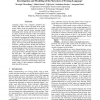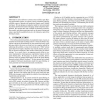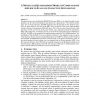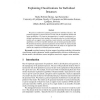1826 search results - page 17 / 366 » Using Random Forests in the Structured Language Model |
IJDAR
2007
13 years 8 months ago
2007
Language usage over computer mediated discourses, like chats, emails and SMS texts, significantly differs from the standard form of the language. An urge towards shorter message l...
CEAS
2006
Springer
14 years 10 days ago
2006
Springer
Motivated by current efforts to construct more realistic spam filtering experimental corpora, we present a newly assembled, publicly available corpus of genuine and unsolicited (s...
IPPS
1998
IEEE
14 years 25 days ago
1998
IEEE
The paper presents how the Random PROLOG Processor (RPP), a bio-inspired model of computations, can be used for formalization and analysis of a phenomenon - the Collective Intelli...
TKDE
2008
13 years 8 months ago
2008
We present a method for explaining predictions for individual instances. The presented approach is general and can be used with all classification models that output probabilities...
ACL
2003
13 years 10 months ago
2003
This paper presents a dependency language model (DLM) that captures linguistic constraints via a dependency structure, i.e., a set of probabilistic dependencies that express the r...




